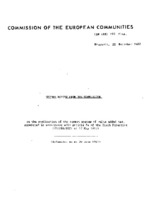Second report from the Commission on the application of the common system of value added tax, Submitted in accordance with Article 34 of the Sixth Directive (77/388/EEC) of 17 May 1977. Situation as at 30 June 1987.

COM Document
Συγγραφέας
EU Commission
Ημερομηνία
1988-12-20Προβολή/
Θεματικές επικεφαλίδες
Taxation ; Value Added TaxΠερίληψη
The First Report on the application of the common system of value added tax (1) was presented to the Council on 22 September 1983 and then transmitted to Parliament. ·All Member States now apply VAT. Portugal is well on the way to setting in place the common VAT system, having replaced its turnover tax arrangements, which applied only at the wholesale stage, with a VAT system very similar to the Community system. The common VAT system was introduced in Spain and Greece on 1 January 1986 and 1 January 1987 respectively. On its accession to the Community, Greece was not required to introduce the system until 1 January 1984. Tto.~o successive deferments meant that the deadline was put back to 1 January 1987 <2>. The Act of Accession of Spain and Portugal specified 1 January 1986 and 1 January 1989 as the respective dates for the systems' introduction in the tto.~o Member States. A joint declaration attached to the Act of Accession provides that, throughout the period of application of the temporary derogation enabling Portugal to postpone the introduction of the common system of VAT, this Member State is to be treated as a third country for the purposes of applying the First, Sixth, Eighth and Tenth VAT Directives. The First Report discussed the difficulties encountered in most Member States in meeting the deadline of 1 January 1978 laid down in the Sixth Directive for incorporating the VAT system into their legislation a11d the need for a Ninth Directive (of 26 June 1978> to authorize certain Member States to defer application of the system until 1 January 1979. The decisions by the Court of Justice regarding the direct rights that may be invoked by taxable persons during the period from 1 January 1 979 to the date on which national legislation is brought into line with the Sixth Directive (1 > has been followed by a decision in Case 70/83 C2>, which concerned a reference to the Court for a preliminary ruling on the interpretation of Article 13CB>Cd>C1> of the Sixth Directive and of Article 1 of the Ninth Directive. In its decision, the Court ruled that, in th~ absence of the implementation of the Sixth Directive, it was possible for the provision concerning the exemption from tax contained in Article 13CB>Cd)(1) of the Sixth Directive to be relied upon by a credit negotiator in relation to transactions carried out between 1 January and 30 June 1978 where he had refrained from passing that tax on to persons following him in the chain of supply. It thus took the view that the Ninth Directive extending the time limit for the entry into force of the Sixth Directive did not have retroactive effect in respect of transactions carried out by economic oper-ators prior to its entry into force. This report will examine in particular the system's internal difficulties, distinguishing between those stemming from the divergences between national laws that the Sixth Directive expressly left untouched CPart I) and those to do with the interpretation of the Directive CPart II>. Part III will look at the main directives proposed or adopted during the review period on the basis of the Sixth Directive. The situation described is that obtaining as at 30 June 1987
Αριθμός σελίδων
71p.Γλώσσα
ΑγγλικάΣημείωση
http://aei.pitt.edu/id/eprint/4088COM (88) 799 final
